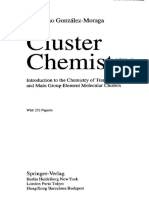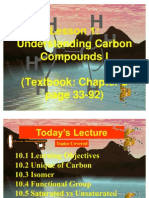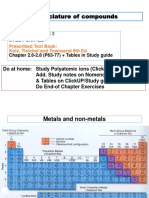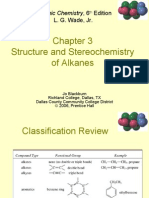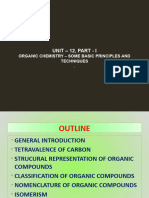Isomerism in Organic Chemistry: Number 93 WWW - Curriculum-Press - Co.uk
Isomerism in Organic Chemistry: Number 93 WWW - Curriculum-Press - Co.uk
Uploaded by
slixsterCopyright:
Available Formats
Isomerism in Organic Chemistry: Number 93 WWW - Curriculum-Press - Co.uk
Isomerism in Organic Chemistry: Number 93 WWW - Curriculum-Press - Co.uk
Uploaded by
slixsterOriginal Description:
Original Title
Copyright
Available Formats
Share this document
Did you find this document useful?
Is this content inappropriate?
Copyright:
Available Formats
Isomerism in Organic Chemistry: Number 93 WWW - Curriculum-Press - Co.uk
Isomerism in Organic Chemistry: Number 93 WWW - Curriculum-Press - Co.uk
Uploaded by
slixsterCopyright:
Available Formats
Isomerism in Organic Chemistry
Number 93
1
C
hem
F
actsheet
www.curriculum-press.co.uk
To succeed in this topic you need to understand:
homologous series (covered in Factsheet 15);
functional groups (covered in Factsheet 15);
empirical formulae (covered in Factsheet 02);
molecular formulae (covered in Factsheet 02);
structural (including displayed) formulae (covered in Factsheet 15);
tetrahedral bonding shapes (covered in Factsheet 04);
naming organic molecules by I.U.P.A.C. rules (covered in Factsheet
15).
After working through this Factsheet you will be able to:
explain what is meant by isomerism;
explain the different sub-groups of isomers;
draw structures of isomers from their molecular formula;
recognise different types of isomer from their structural formulae.
Organic molecules number many millions. Carbon, hydrogen, oxygen,
nitrogen and halogen atoms form the few basic building units of most
organic molecules but, by varying their numbers and how they are bonded
relative to each other, these millions of different molecules are possible.
One of the reasons for this diversity is the occurrence of isomerism which
is concerned with the how the atoms are bonded relative to each other,
rather than how many are present.
C
4
H
10
is a molecular formula; it relates to all molecules composed of four
carbon atoms and ten hydrogen atoms. However, if all possible structural
formulae with this same molecular formula are drawn (Fig1)
C C C C H H
H H H H
H H H H
C C C H H
H H
H H H
C H H
H
or CH
3
CH
2
CH
2
CH
3
or CH
3
CH(CH
3
)CH
3
and
or
OCR only
or
OCR only
These represent
BUTANE
But these represent
METHYLPROPANE
B
o
t
h
a
r
e
C
4
H
1
0
Note: they may take more time and effort but, unless specified
otherwise, full displayed structures are usually the best ones to use,
especially in this context.
This example illustrates what is meant by isomerism. Butane and
methylpropane are said to be isomers of each other or isomeric or
isomers of C
4
H
10
.
This leads to the first important definition:
Isomers are molecules with the same molecular formula, but
different arrangements of atoms.
Fig 1. Structural formulas of C
4
H
10
Isomers may have significant differences in chemical properties only, in physical properties only or in both. Butane and methylpropane, for example have
very similar chemical properties but quite different physical properties. Mostly as a result of this, isomerism is sub-divided into various types (Fig 2).
Isomers
(molecules with the same molecular formula, but different arrangements of atoms)
Structural Isomers
(isomers resulting from different bonding
patterns between the atoms)
Stereoisomers
(isomers resulting from different spatial arrangements
of the atoms in the same structural formula)
Chain Isomers
are isomers
resulting from the
atoms being
bonded to form
different
arrangements of
the carbon
atoms.
Positional Isomers
are isomers resulting
from the atoms being
bonded so that the
functional groups
are in different
positions on the
same carbon chain.
Functional
Group Isomers
are isomers
resulting from the
atoms being
bonded to form
different
functional
groups.
Geometrical Isomers
are isomers resulting from
the atoms being bonded to
form different
arrangements of same
groups around a planar
group such as the C=C
group.
Optical Isomers (A2)
are isomers resulting from
the atoms being bonded to
form different 3D
arrangements, around a
central carbon atom,
which are non-identical
mirror images of each
other.
Functional
Group Isomers
are isomers
resulting from the
atoms being
bonded to form
different
functional
groups.
Fig 2.
Chem Factsheet
2
93. Isomerism in Organic Chemistry
Structural Isomers 1: Chain Isomers
Remember: Isomers resulting from the atoms being bonded to form
different arrangements of the carbon atoms
Our first example showed chain isomers. Butane and methylpropane differ
only in the bonding pattern of the four carbon atoms; the former is a
straight-chain isomer but the latter is a branched-chain isomer. If only
chain isomerism applies (as here), the isomers will belong to the same
homologous series and have very similar chemistry but different physical
properties. For example, methylpropane has a noticeably lower boiling
point.
Note: the petrochemical industry converts a lot of straight chain isomers
into branched chain isomers because the latter act as better fuels in
petrol engines. Not surprisingly, they call the process isomerisation!
Another example of chain isomerism is C
5
H
12.
CH
3
CH
2
CH
2
CH
2
CH
3
pentane
CH
3
CH(CH
3
)CH
2
CH
3
2-methylbutane
CH
3
C(CH
3
)
2
CH
3
2-2dimethylpropane
Q1 Draw and name the structures of the five chain isomers of C
6
H
14
.
Structural Isomers 2: Positional Isomers
Remember: Isomers resulting from the atoms being bonded so that the
functional groups are in different positions on the same carbon chain.
C
3
H
7
Br illustrates this type of isomerism. The three carbon atoms form a
chain but the bromine atom may be bonded to either the end (at C1) or
middle (at C2) of the chain. Hence, the positional isomers of C
3
H
7
Br are:
1-bromopropane and 2-bromopropane
CH
3
CH
2
CH
2
Br CH
3
CHBrCH
3
If only positional isomerism applies, the isomers will again belong to the
same homologous series and have very similar chemistry but different
physical properties. However, for some examples, the reaction products
may vary from positional isomer to positional isomer. For example, as you
will encounter when you study the halogenoalkanes, elimination of hydrogen
bromide from 1-bromobutane produces only one alkene type product
whereas its positional isomer, 2-bromobutane, produces three.
Here are some more examples.
(a) butan-1-ol and butan-2-ol
[CH
3
CH
2
CH
2
CH
2
OH] [CH
3
CH
2
CH(OH)CH
3
]
(b) 1,1-dicloroethane and 1,2-dicloroethane
[CHCl
2
CH
3
] [CH
2
ClCH
2
Cl]
(c) pentan-2-one and pentan-3-one
[CH
3
CO.CH
2
CH
2
CH
3
] [CH
3
CH
2
CO. CH
2
CH
3
]
Exam Hint: Examine all the possible carbon chains in a systematic
fashion. Draw the maximum number of carbons in one continuous
chain first (e.g. 6 in the following question). Then consider all possible
variations of a 5C chain with a 1C side-chain. Then consider all
possible variations of a 4C chain with two 1C side-chains etc. If you
have time, naming each will show whether you have repeated a structure
because each should have a unique name.
A2 Only: Benzene derivatives (C
6
H
6
;
)commonly show positional
isomerism.
Di-substituted benzene derivatives occur as three positional isomers. For
example:
NO
2
NO
2
NO
2
NO
2
NO
2
NO
2
1,2-dinitrobenzene 1,3-dinitrobenzene 1,4-dinitrobenzene
One last point! Chain and positional isomerism can occur together. For
example, there are four isomers of C
4
H
10
F. These are:
(a) 1-fluorobutane
[CH
3
CH
2
CH
2
CH
2
F]
(b) 2-fluorobutane
[CH
3
CH
2
CHFCH
3
]
(c) 1-fluoro-2-methylpropane
[CH
3
CH(CH
3
)CH
2
F]
(d) 2-fluoro-2-methylpropane
[CH
3
CF(CH
3
)CH
3
]
A similar pattern is shown by the isomeric alcohols with molecular formula
C
4
H
10
O. The straight chain positional isomers have already been considered
but the full set of isomers is:
(a) butan-1-ol
[CH
3
CH
2
CH
2
CH
2
OH]
(b) butan-2-ol
[CH
3
CH
2
CH(OH)CH
3
]
(c) 2-methylpropan-1-ol
[CH
3
CH(CH
3
)CH
2
OH]
(d) 2-methylpropan-2-ol
[CH
3
C(OH)(CH
3
)CH
3
].
(a) and (b) are positional isomers
(c) and (d) are positional isomers
(a) and (c) are chain isomers
(b) and (d) are chain isomers
but (a) and (d) and (b) and (c) are
a mixture of both!
Note: Isomers (a) and (c) are called
primary alcohols because both
contain a CH
2
OH group. (b) is a
secondary alcohol since it contains a
-CH(OH)- group and (d) is a
tertiary alcohol since it contains a
>C(OH)- group. As you will see
when you study alcohols, these
different types have some
significantly different chemical
reactions.
Exam Hint: Examine all the positional variations in a systematic
fashion. First draw the basic carbon chain (e.g. C-C-C in the following
question). Then consider all possible positional variations of the
additional functional groups.
Q2 Draw and name the structures of the four positional isomers of C
3
H
6
Cl
2
.
Exam Hint: If positional isomerism only is occurring, the names
vary only in the numbering pattern. Try naming your isomers to check
they are genuine positional isomers.
Chem Factsheet
3
93. Isomerism in Organic Chemistry
Structural Isomers 3 : Functional Group Isomers
Remember: Isomers resulting from the atoms being bonded to form
different functional groups.
For molecules with three or more carbon atoms, aldehydes and ketones can
show functional group isomerism. Similarly, carboxylic acids and esters
can show functional group isomerism whilst, in A2, you will also encounter
primary, secondary and tertiary amine functional group isomers. Of course,
since organic molecules chemical properties are controlled by their functional
groups, functional group isomers are extremely different in their chemistry.
Also, since different functional groups often result in different inter-
molecular forces, physical properties can be very different.
Aldehydes and ketones
C
3
H
6
O could be propanal [CH
3
CH
2
CHO an aldehyde] or propanone
[CH
3
CO.CH
3
a ketone].
Similarly, C
4
H
8
O could be butanal [CH
3
CH
2
CH
2
CHO] or butanone
[CH
3
CH
2
CO.CH
3
].
Linked to these, there is also a chain isomer of butanal. This is
methylpropanal, [CH
3
CH(CH
3
)CHO].
Exam Hint: Draw the functional group first and then add the remaining
atoms in all their possible chain and positional variations.
Q3 Draw and name the structures of the seven isomers of C
5
H
10
O. Restrict
your answers to aldehydes or ketones but remember to include chain and
positional variations.
Carboxylic acids and esters
C
2
H
4
O
2
could be: ethanoic acid [CH
3
CO.OH an acid] or
methyl methanoate [HCO.OCH
3
an ester].
Similarly, C
3
H
6
O
2
could be: propanoic acid [CH
3
CH
2
CO.OH],
methyl ethanoate [CH
3
CO.OCH
3
] or ethyl methanoate [HCO.OCH
2
CH
3
]
Q4 Draw and name the structures of the six isomers of C
4
H
8
O
2
. Restrict
your answers to acids or esters but remember to include chain and positional
variations.
Primary, secondary and tertiary amines (A2 only):
C
2
H
7
N could be:
aminoethane (ethylamine) [CH
3
CH
2
NH
2
a primary amine] or
N-methylaminomethane (N-methylmethylamine) [(CH
3
)
2
NH a secondary
amine].
Similarly, C
3
H
9
N could be:
1-aminopropane [CH
3
CH
2
CH
2
NH
2
], 2-aminopropane [CH
3
CH(NH
2
)CH
3
],
N-methylaminoethane [CH
3
NHCH
2
CH
3
] or N,N-dimethylaminomethane
[(CH
3
)
3
N a tertiary amine]. Note again how positional isomerism also
occurs.
Q5 Draw and name the structures of the eight isomers of C
4
H
11
N. Restrict
your answers to amines but remember to include chain and positional
variations.
Stereoisomers 1 : Geometrical Isomers
Remember: Isomers resulting from the atoms being bonded to form
different arrangements of same groups around a planar group such
as the C=C group.
Geometrical isomerism (also known as cis-trans isomerism) can occur in
many types of molecules but you should concentrate on examples involving
alkenes. Such isomerism tends to cause the isomers to have very different
physical properties but, since the functional groups have not changed,
very similar chemical properties.
Single covalent C-C bonds (sigma bonds) are free to rotate about their axis.
However, when the Pi bond is added to form a double covalent C=C bond,
this ability to rotate is lost. Also the C=C atoms and the four atoms
directly bonded to them are forced to lie in the same plane.
C C
Free rotation; non-planar No free rotation;planar
C C
Consider the following general structures where X and Y represent various
atoms or groups other than H that may be bonded to the C=C carbons.
Because of the planar and non-rotating nature of the C=C bond, these
structures have the same molecular formula but are non-identical; in other
words they are isomers. In fact they are geometrical isomers. As shown,
the isomer with X and Y on the same side of the C=C bond is referred to as
the cis isomer whereas the other is called the trans isomer.
Some examples of this type of isomerism include:
1. Geometrical isomers of but-2-ene
C C
H
H
Y
X
trans-isomer
C C
H H
Y
X
cis-isomer
C C
H
CH
3
H
CH
3
cis-but-2-ene
C C
H
H
CH
3
CH
3
trans-but-2-ene
2. Geometrical isomers of 2,3-dichloropent-2-ene
C C
Cl
CH
2
CH
3
Cl
CH
3
cis-2,3-dichloropent-2-ene
C C
Cl
CH
2
CH
3
Cl
CH
3
trans-2,3-dichloropent-2-ene
Note: Example 2 shows that the
similar atoms bonded to C=C do not
have to be H atoms. However, the two
groups bonded to any particular C=C
carbon must not be the same. This
occurs in but-1-ene, resulting in no
geometrical isomers. Similar examples
would be 1,2-difluoroethene which
does have geometrical isomers whereas
1,1-difluoroethene does not.
C C
H
CH
2
CH
3
H
H
but-1-ene
Q6 (a) Draw and name the structures of geometrical isomers of (a) hex-3-ene
(b) 1,2-dibromoethene
(c) 2-chlorobut-2-ene.
Exam Hint: Draw the C=C bond with its four other bonds and
then fit in the other atoms or groups. Remember, neither C of
the C=C bond can be bonded to the same group.
Chem Factsheet
4
93. Isomerism in Organic Chemistry
Stereoisomers 2 : Optical Isomers (A2 only)
Remember.: Isomers resulting from the atoms being bonded to form
different 3D arrangements, around a central carbon atom, which
are non-identical mirror images of each other.
Optical isomers (also known as enantiomers) always occur in pairs and
have identical chemical and physical properties, except that one structure
rotates the plane of plane-polarized light (p.p.l.) clockwise and the other
rotates it anti-clockwise. This is referred to as their optical activity.
These are mirror images of each other, yet they are non-identical. Chiral
is term used to describe such molecules. Hence, they are optical isomers of
each other. The non-identicality can be seen by imagining looking down
on the molecules from above group W. The remaining groups in clockwise
order would be Z-Y-X for isomer A but Z-X-Y for B.
Optical isomers can
occur if there is an
asymmetric (also called
chiral) carbon atom
(marked *). This is a
carbon atom which is
bonded (tetrahedrally) to
four different groups.
Consider the general
structures shown, where
W-Z represent these four
different groups.
imaginary
mirror
C
X
Y
W
Z
*
C
X
Y
W
Z
*
Notes: (a) Inter-changing any two groups in isomer A produces isomer
B, and vice-versa.
(b) The direction of rotation of p.p.l. cannot be predicted from
the structure.
Some examples of optical isomers are:
(1) Optical isomers of butan-2-ol
(2) optical isomers of 2-aminopropanoic acid
(alanine an -amino acid)
C
H
CH
2
CH
3
OH
CH
3
*
C
H
CH
2
CH
3
OH
H
3
C
*
C
H
NH
2
COOH
CH
3
*
C
H
H
2
N
HOOC
H
3
C
*
Exam Hint: When drawing optical isomers, 3D diagrams are essential.
CLEARLY draw the 3D representation for the tetrahedral carbon atom
with its four bonds and then fit in the four different atoms or groups.
Finally, copy your first structure in an imaginary mirror (or exchange
any two groups) to obtain the second isomer.
Q7 Marking the asymmetric carbon with an asterisk, draw structures of
the optical isomers of:
(a) 2-methylhexane (b) 2-chlorobutan-1-ol (c) 1-chloro-1-fluoroethane.
C C
Br
Br
cis-1,2-dibromethane
H H
C C
Br
H
trans-1,2-dibromethane
H Br
(C)
C C
Cl
H
cis-2-chloro-but-2-ene
CH
3
C C
Cl
CH
3
trans--2-chloro-but-2-ene
CH
3
H CH
3
(b)
C C
H
H
CH
3
CH
2
cis-hex-3-ene
C C
H
H
CH
2
CH
3
trans-hex-3-ene
CH
3
CH
2
Q7 (a)
(b)
C
H
CH
2
CH
3
CH
2
CH
2
CH
3
CH
3
*
C
H
H
3
C
*
CH
3
CH
2
CH
2
CH
3
CH
2
C
H
CH
2
CH
3
CH
2
OH
Cl
*
C
H
Cl *
HOH
2
C
CH
3
CH
2
(c)
C
H
F
Cl
CH
3
*
C
H
H
3
C *
F
Cl
Answers to questions in text
Q1 CH
3
CH
2
CH
2
CH
2
CH
2
CH
3
hexane ;
CH
3
CH(CH
3
)CH
2
CH
2
CH
3
2-methylpentane ;
CH
3
CH
2
CH(CH
3
)CH
2
CH
3
3-methylpentane;
CH
3
C(CH
3
)
2
CH
2
CH
3
2,2-dimethylbutane ;
CH
3
CH(CH
3
)CH(CH
3
)CH
3
2,3-dimethylbutane.
Q2 CH
3
CH
2
CHCl
2
1,1-dichloropropane ;
CH
3
CCl
2
CH
3
2,2-dichloropropane ;
CH
3
CHClCH
2
Cl
1,2-dichloropropane
CH
2
ClCH
2
ICH
2
Cl - 1,3-dichloropropane
Q3 CH
3
CH
2
CH
2
CH
2
CHO
pentanal ;
CH
3
CO.CH
2
CH
2
CH
3
pentan-2-one ;
CH
3
CH
2
CO.CH
2
CH
3
pentan-3-one ;
CH
3
CH
2
CH(CH
3
)CHO
2-methylbutananal ;
CH
3
CH(CH
3
)CH
2
CHO 3-methylbutananal ;
CH
3
CO.CH(CH
3
)CH
3
3-methylbutan-2-one ;
CH
3
C(CH
3
)
2
CHO
2,2-dimethylpropanal
Q4 CH
3
CH
2
CH
2
COOH
butanoic acid ;
CH
3
CH(CH
3
)COOH
2-methylpropanoic acid ;
CH
3
CH
2
COOCH
3
methyl propanaote ;
CH
3
COOCH
2
CH
3
ethyl ethanoate ;
HCOOCH
2
CH
2
CH
3
(1-propyl) methanoate ;
HCOOCH(CH
3
)CH
3
(2-propyl) methanoate ;
Q5 CH
3
CH
2
CH
2
CH
2
NH
2
1-aminobutane ;
CH
3
CH
2
CH(NH
2
)CH
3
2-aminobutane ;
CH
3
CH(CH
3
)CH
2
NH
2
1-amino-2-methylpropane ;
CH
3
C(CH
3
)
2
NH
2
2-amino-2-methylpropane ;
CH
3
CH
2
CH
2
NHCH
3
N-methyl-1-aminopropane ;
CH
3
CH(CH
3
)NHCH
3
N-methyl-2-aminopropane ;
CH
3
CH
2
NHCH
2
CH
3
N-ethyl-aminoethane ;
CH
3
CH
2
N(CH
3
)
2
N,N-dimethyl-aminoethane.
Q6 (a) CH
2
CH
3
Chem Factsheet
5
93. Isomerism in Organic Chemistry
Practice Questions
1. Which of the following isomers of C
4
H
11
N can exist as optical isomers?
CH
3
CH
2
CH
2
CH
2
NH
2
1-aminobutane
CH
3
CH
2
CH(NH
2
)CH
3
2-aminobutane
CH
3
CH(CH
3
)CH
2
NH
2
1-amino-2-methylpropane
CH
3
C(CH
3
)
2
NH
2
2-amino-2-methylpropane
CH
3
CH
2
CH
2
NHCH
3
N-methyl-1-aminopropane
CH
3
CH(CH
3
)NHCH
3
N-methyl-2-aminopropane
CH
3
CH
2
NHCH
2
CH
3
N-ethyl-aminoethane
CH
3
CH
2
N(CH
3
)
2
N,N-dimethyl-aminoethane
Illustrate your answer with appropriate structures and mark the chiral
centre with an asterisk.
2. Draw and name all the isomers of C
3
H
5
Cl. State the types of isomerism
that occur.
3. Draw and name
(a) a chain isomer of 1-bromobutane
(b) a positional isomer of 2-bromo-2-methylbutane
(c) a functional straight-chain isomer (containing a single functional
group) of pentanoic acid
4. Write down the formulae and names of the four alcohols, corresponding
to the formula C
4
H
9
OH, which are structural isomers of one another.
5. Compounds of molecular formula C
4
H
10
O can exhibit skeletal
isomerism, positional isomerism, functional group isomerism and
stereoisomerism.
(a) Write down the structural formulae of suitable pairs of compounds
that show:
(i) skeletal isomerism
(ii) positional isomerism
(iii) stereoisomerism
(b) Explain why it is that compounds of molecular formula C
4
H
10
O
can exhibit one kind of stereoisomerism but not another.
Acknowledgements: This Factsheet was researched and written by Mike Hughes Curriculum Press, Bank House, 105 King Street, Wellington, Shropshire, TF1
1NU. ChemistryFactsheets may be copied free of charge by teaching staff or students, provided that their school is a registered subscriber. No part of these
Factsheets may be reproduced, stored in a retrieval system, or transmitted, in any other form or by any other means, without the prior permission of the
publisher. ISSN 1351-5136
Answers
1. CH
3
CH
2
CH(NH
2
)CH
3
2-aminobutane
2. CH
2
=CHCH
2
Cl 3-chloropropene ; CH
2
=CClCH
3
2-chloropropene;
All four are positional isomers of each other but 1-chloroproene also
shows geometrical isomerism.
3. (a) CH
3
CH(CH
3
)CH
2
Br 1-bromo-2-methylbutane
(b) CH
3
CH(CH
3
)CH
2
CH
2
Br - 1-bromo-3-methylbutane
or CH
3
CH(CH
3
)CHBrCH
3
- 2-bromo-3-methylbutane
or CH
2
BrCH(CH
3
)CH
2
CH
3
- 1-bromo-2-methylbutane
(c) CH
3
CH
2
CH
2
CO.OCH
3
- methyl butanoate
or CH
3
CH
2
CO.OCH
2
CH
3
- ethyl propanoate
or CH
3
CO.OCH
2
CH
2
CH
3
- propyl ethanoate
or HCO.OCH
2
CH
2
CH
2
CH
3
- butyl methanoate
4. CH
3
CH
2
CH
2
CH
2
OH - butan-1-ol
(CH
3
)
2
CHCH
2
OH - 2-methylpropan-1-ol
CH
3
CH(OH)CH
2
CH
3
- butan-2-ol
(CH
3
)
3
COH - 2-methylpropan-2-ol
5. (a) (i) CH
3
CH
2
CH
2
CH
2
OH and (CH
3
)
2
CHCH
2
OH
or (CH
3
)
3
COH and CH
3
CH(OH)CH
2
CH
3
(ii) CH
3
CH
2
CH
2
CH
2
OH and CH
3
CH(OH)CH
2
CH
3
or (CH
3
)
2
CHCH
2
OH and (CH
3
)
3
COH
(iii)
(b) Butan-2-ol has a chiral centre / asymmetric C atom can exhibit
optical isomerism / exist in two non-superimposable forms
but none of the compounds has a C = C bond (or other structural
feature) which can cause restricted rotation of atoms
there is no possibility of geometrical isomerism / existence of cis
and trans isomers
C C
H
H
cis-1-chloro-propene
Cl CH
3
C C
N
CH
3
trans-1-chloro-propene
Cl H
C
H
NH
2
CH
2
CH
3
CH
3
*
C
H
H
3
C
*
CH
3
CH
2
H
2
N
C
CH
3
C
2
H
5
OH
H
and
C
CH
3
C
2
H
5
HO
H
You might also like
- 170 How To Answer As Level Questions On EquilibraNo ratings yet170 How To Answer As Level Questions On Equilibra4 pages
- 175 Essential Laboratory Procedures - PSAs As Part I100% (1)175 Essential Laboratory Procedures - PSAs As Part I5 pages
- Chemical Kinetics: SR - 12 Class Chemistry Vol-2No ratings yetChemical Kinetics: SR - 12 Class Chemistry Vol-278 pages
- Organic Compound Nomenclature and CharacteristicNo ratings yetOrganic Compound Nomenclature and Characteristic8 pages
- Topic 12 Entropy-Energetics Chemistry Ial EdexcelNo ratings yetTopic 12 Entropy-Energetics Chemistry Ial Edexcel26 pages
- 15.2 Born-Haber Cycle: 15.2.2 Explain How The Relative Sizes and The Charges of IonsNo ratings yet15.2 Born-Haber Cycle: 15.2.2 Explain How The Relative Sizes and The Charges of Ions16 pages
- Organic Reaction Mechanism Notes-Part INo ratings yetOrganic Reaction Mechanism Notes-Part I13 pages
- AP Chemistry Bonding Help Sheet: 2, (Diamond)No ratings yetAP Chemistry Bonding Help Sheet: 2, (Diamond)6 pages
- Hsslive-Xi-Chem-12. Organic Chemistry Some Basic Principles and Techniques100% (1)Hsslive-Xi-Chem-12. Organic Chemistry Some Basic Principles and Techniques27 pages
- (Module 2) Chemical Reaction and StoichiometryNo ratings yet(Module 2) Chemical Reaction and Stoichiometry14 pages
- New Module-2 Inorganic and Organometallic Chem Fall-2023No ratings yetNew Module-2 Inorganic and Organometallic Chem Fall-202367 pages
- Nomenclature of Organic Compounds - pdf-67No ratings yetNomenclature of Organic Compounds - pdf-678 pages
- Unit 12 - Non-Metals and Their Compounds Teacher VersionNo ratings yetUnit 12 - Non-Metals and Their Compounds Teacher Version49 pages
- CHM 171 Study Unit 2.2 Nomenclature of Compounds100% (1)CHM 171 Study Unit 2.2 Nomenclature of Compounds40 pages
- (19th of 19 Chapters) Organic Chemistry Part 1 of 3 - GCE O Level Chemistry LectureNo ratings yet(19th of 19 Chapters) Organic Chemistry Part 1 of 3 - GCE O Level Chemistry Lecture37 pages
- Stereochemistry Basic Concepts Useful Notes For StudentsNo ratings yetStereochemistry Basic Concepts Useful Notes For Students26 pages
- Reaction Intermediates: Types of Bond CleavagesNo ratings yetReaction Intermediates: Types of Bond Cleavages31 pages
- Structure and Stereochemistry of AlkanesNo ratings yetStructure and Stereochemistry of Alkanes56 pages
- The Chemistry of Carbon - Formula & Isomerosm - TCC - 1mac2024No ratings yetThe Chemistry of Carbon - Formula & Isomerosm - TCC - 1mac202423 pages
- Module 1. The Chemistry of Carbon Compounds TOPIC: Structure and FormulaeNo ratings yetModule 1. The Chemistry of Carbon Compounds TOPIC: Structure and Formulae38 pages
- Topic 11 - Introduction To Organic ChemistryNo ratings yetTopic 11 - Introduction To Organic Chemistry102 pages
- International Newsletter: Careers Network For International StudentsNo ratings yetInternational Newsletter: Careers Network For International Students5 pages
- CHEM 103 Exp 11 Spectrophometry UV-Vis NEWNo ratings yetCHEM 103 Exp 11 Spectrophometry UV-Vis NEW8 pages
- Findings 281: Criminal Careers and Life Success: New Findings From The Cambridge Study in Delinquent DevelopmentNo ratings yetFindings 281: Criminal Careers and Life Success: New Findings From The Cambridge Study in Delinquent Development6 pages
- PMR Spectroscopy: Solved Problems Volume : IIFrom EverandPMR Spectroscopy: Solved Problems Volume : II
- 175 Essential Laboratory Procedures - PSAs As Part I175 Essential Laboratory Procedures - PSAs As Part I
- 15.2 Born-Haber Cycle: 15.2.2 Explain How The Relative Sizes and The Charges of Ions15.2 Born-Haber Cycle: 15.2.2 Explain How The Relative Sizes and The Charges of Ions
- Hsslive-Xi-Chem-12. Organic Chemistry Some Basic Principles and TechniquesHsslive-Xi-Chem-12. Organic Chemistry Some Basic Principles and Techniques
- New Module-2 Inorganic and Organometallic Chem Fall-2023New Module-2 Inorganic and Organometallic Chem Fall-2023
- Unit 12 - Non-Metals and Their Compounds Teacher VersionUnit 12 - Non-Metals and Their Compounds Teacher Version
- (19th of 19 Chapters) Organic Chemistry Part 1 of 3 - GCE O Level Chemistry Lecture(19th of 19 Chapters) Organic Chemistry Part 1 of 3 - GCE O Level Chemistry Lecture
- Stereochemistry Basic Concepts Useful Notes For StudentsStereochemistry Basic Concepts Useful Notes For Students
- The Chemistry of Carbon - Formula & Isomerosm - TCC - 1mac2024The Chemistry of Carbon - Formula & Isomerosm - TCC - 1mac2024
- Module 1. The Chemistry of Carbon Compounds TOPIC: Structure and FormulaeModule 1. The Chemistry of Carbon Compounds TOPIC: Structure and Formulae
- International Newsletter: Careers Network For International StudentsInternational Newsletter: Careers Network For International Students
- Findings 281: Criminal Careers and Life Success: New Findings From The Cambridge Study in Delinquent DevelopmentFindings 281: Criminal Careers and Life Success: New Findings From The Cambridge Study in Delinquent Development














